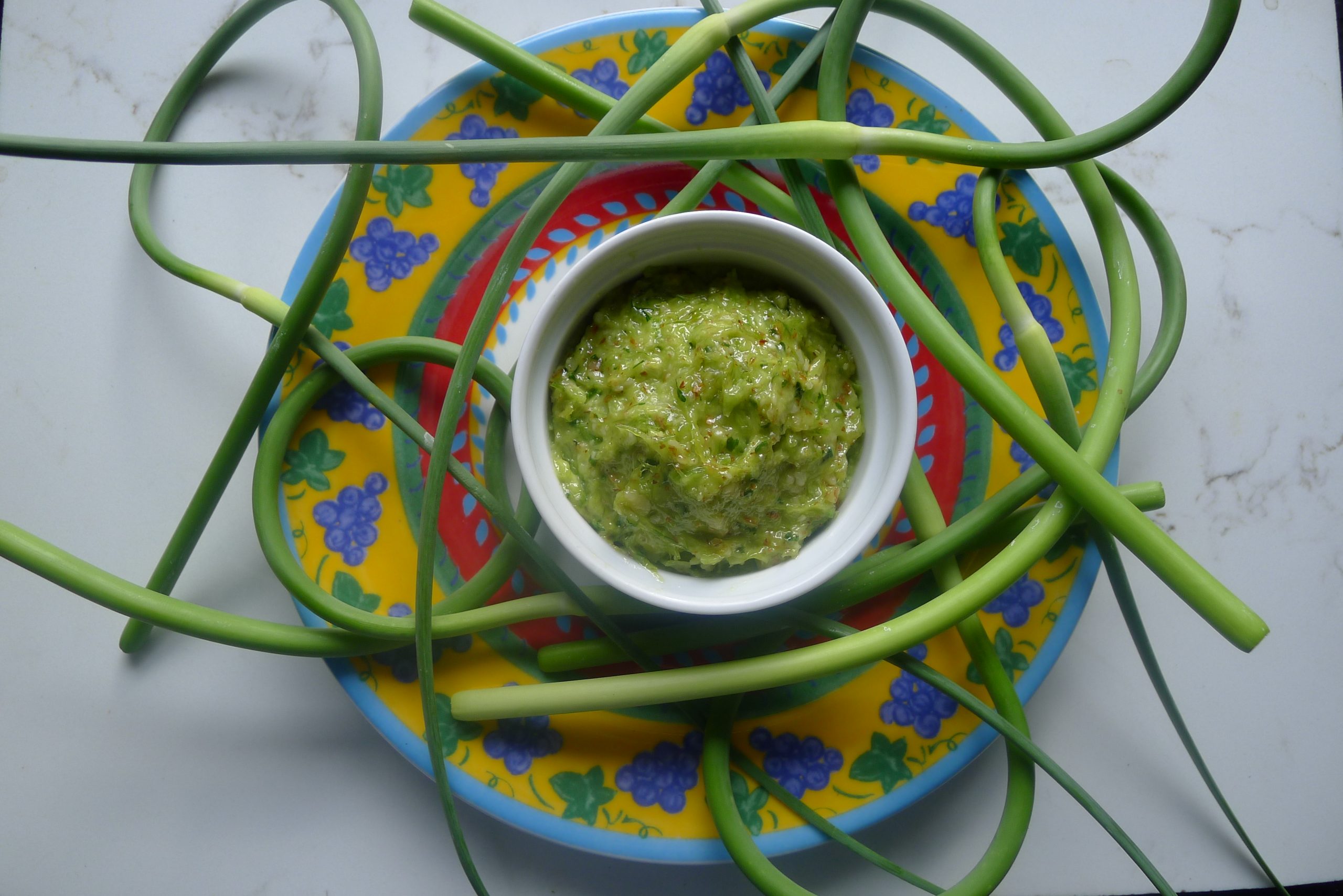Downloads: Word.doc Image #1 Image #2
Other images available on request
Return to Editor’s Lounge
Copyright Ari LeVaux 2020. No reprints or sharing without permission

Toum ’til you Swoon
Each spring it happens. You cut into a clove of garlic, only to find its lily white interior tainted by the green stripe of a developing shoot. A few weeks later, sprouts will emerge from the tips of every garlic clove in the house, turning entire bulbs into Medusa heads.
During this period of garlic awakening, all cooks face a choice. Either dig out the little plant or cook with it undaunted, knowing the verdant imperfection tastes exactly like the bulb that hosts it.
And every year, some aspiring garlic growers will fall under the spell of a sprouted clove, and decide to plant the little guy in the dirt. The math of garlic propagation dictates that every planted clove will turn into a full bulb of cloves, so why not?
Alas, sprouted garlic sown in springtime won’t bulb. The clove must overwinter in the dirt. Planted in fall, it will sense the moist earth and send out roots, and then hibernate through the winter. When we see that green stripe in the garlic clove on the cutting board, we know the cloves in the garden are waking up too.
Fast forward to the present moment: the garlic I planted last fall is now producing delicious shoots called scapes, curly stems with pointy flower-like tips that emerge from the center of the plant around the summer solstice.
Garlic growers will diligently pick every scape, so as to encourage the plant to focus on its below-ground portion. And garlic lovers are happy to buy and eat scapes as a seasonal treat. Use the scapes exactly how you would garlic, as a spice or vegetable. It’s fun chopped in stir-fries, or steamed whole, or held and chomped on like curly green cigars on poker night, or woven into garlands and placed atop our heads while we prance about like Greek divinity.
Scapes are readily available these days at the farmers market. And if you have designs to plant your own garlic this fall, now is the perfect time to plan your patch. Going to the farmers market now in search of scapes to eat can be an important first step in finding your source for the seed garlic that you will plant in October.
“Seed garlic” is just regular garlic that is certified to be disease-free, and of a particular variety. One advantage of getting your seed garlic locally is you can see for yourself how well the garlic in question produces in your own climate. As a home gardener, you don’t have to worry about the financial devastation of a diseased garlic crop. And who really cares what variety of garlic you grow, as long as it grows well in your neck of the woods.
So be on the lookout for scapes at the farmers market, because the people selling them will have garlic to sell in about a month. Talk to the growers. Find out what varieties they grow. Look for scapes that are thick, because thick scapes come from thick plants, and girth indicates bulb size. Make notes, and come back in a month to see what those bulbs look like.
Where I live, Romanian Red is the garlic to grow. The cloves are big, easy to peel, not too spicy, and very tasty. If you want to try a specific kind of garlic, ordering it online is your best bet. And you should order soon. Many of the popular varieties, like Romanian Red, will sell out before they are even harvested. I recommend buying garlic from Filaree Farm in central Washington state, because its founder Ron Engeland wrote “Growing Great Garlic,” the only reference you need for garlic cultivation. I didn’t get my Romanian Red from Engelend, but rather we both got it from the same source: Idaho’s late, great Jack Ronniger, keeper of the best garlic and rare potato strains.
One of my favorite things to do with garlic, be it bulb, sprout or scape, is make toum, a Lebanese aioli-like sauce of garlic, salt and olive oil. Even though it’s mostly garlic, and thus quite strong, toum is so maddenly delicious you will spread it everywhere. Since I currently have shopping bags full of scapes, I’ve been making toum from those. It freezes well, in theory, although in practice toum doesn’t seem to last long enough to get frozen. It does take a toll on the breath, but in these socially distant times, who cares? Eat toum off the spoon ’til you swoon.
Scape Toum
This assertive, pale green paste makes a great spread, filling or ingredient. The nuts and parsley add a rich thickness and grassy fragrance, making it something of a cross between pesto and romesco sauce.
Scapes have more fiber than bulb garlic, so it takes longer in the blender. But with patience the scape toum will emulsify just like bulb toum.
Serves 10
1 cup almonds
2 teaspoons salt
2 cups chopped scapes
2 cups olive oil
1 cup chopped parsley
Zest and juice of ½ a lemon
Pulse the almonds and salt in a blender until the almonds are crushed. Add the scapes and blend, scraping down the sides as necessary. Add the first cup of olive oil, a little at a time, again scraping the sides as necessary. Add the lemon juice and zest and parsley, and blend until the parsley disappears. The second cup of oil is optional. The paste will loosen as you add it, and then, surprisingly, thicken even more.
You can also skip the almonds, for a smoother, creamier final product. In that case, cut the salt in half, and stop at a single cup of oil.
Spread toum on anything that moves. Wrap it in romaine leaves with chunks of feta. Refrigerate or freeze the unused portions.